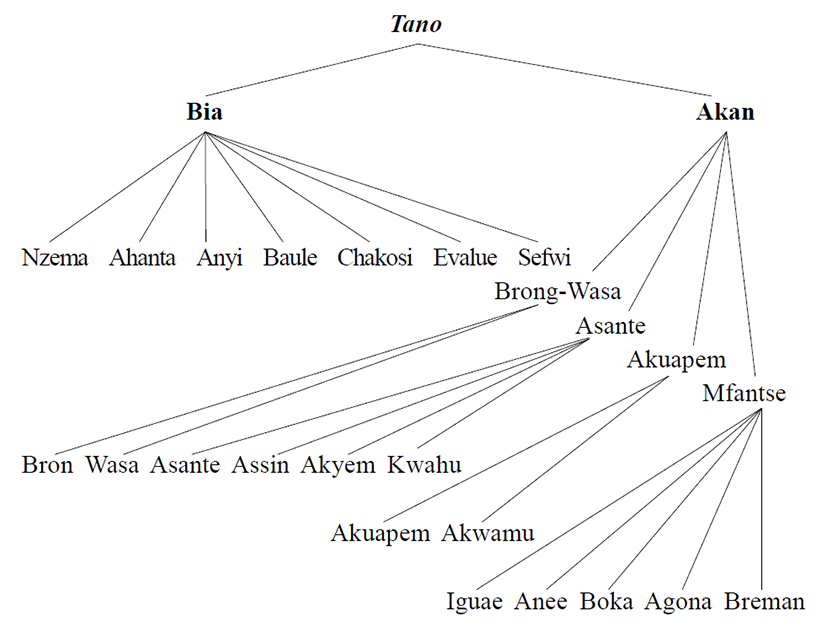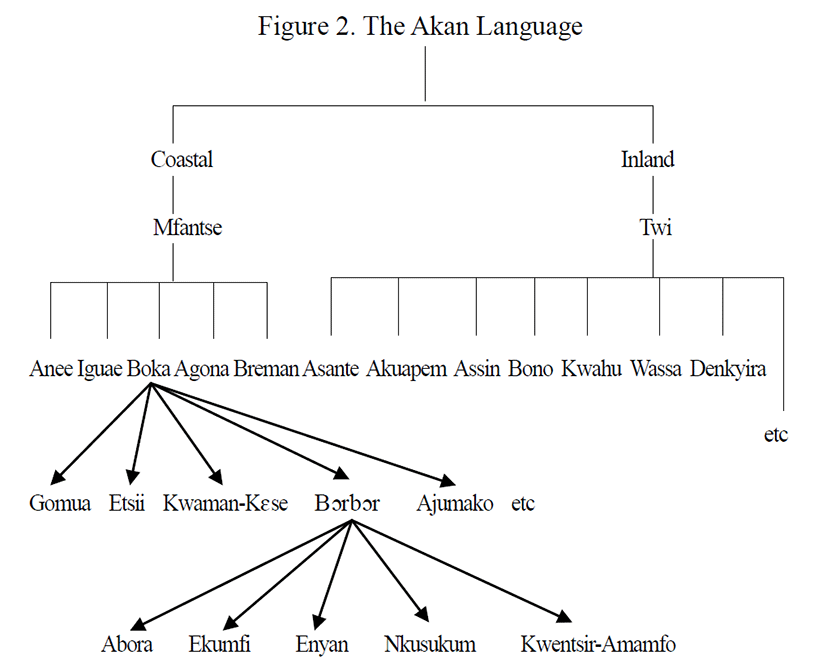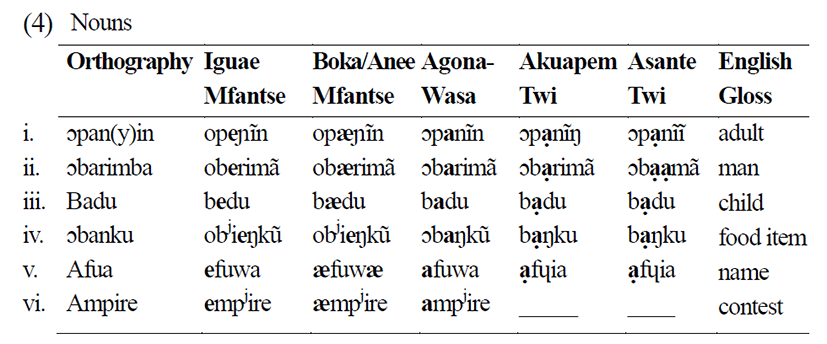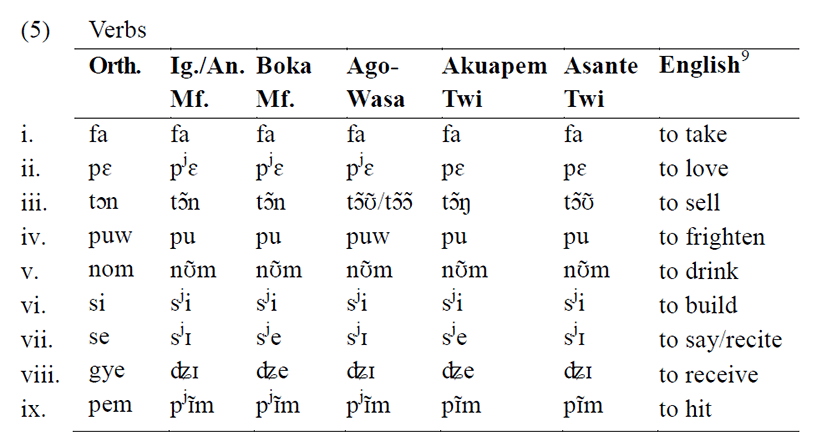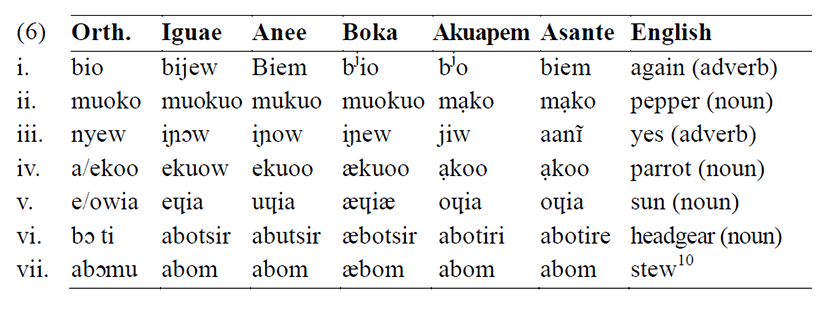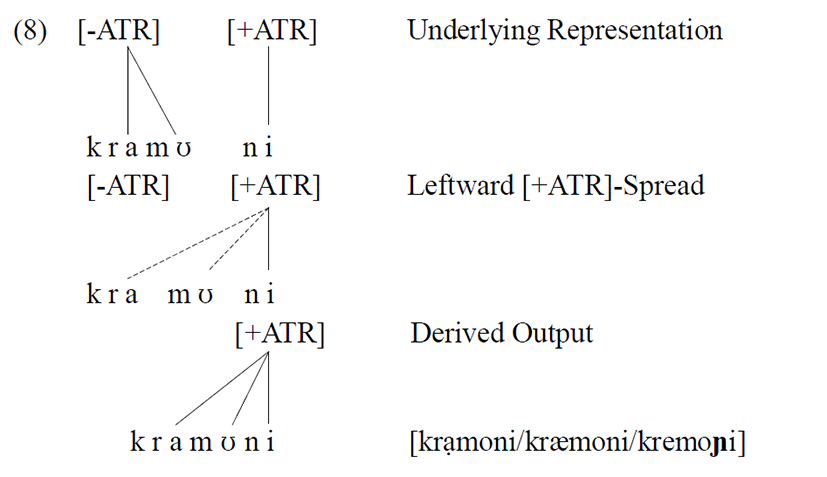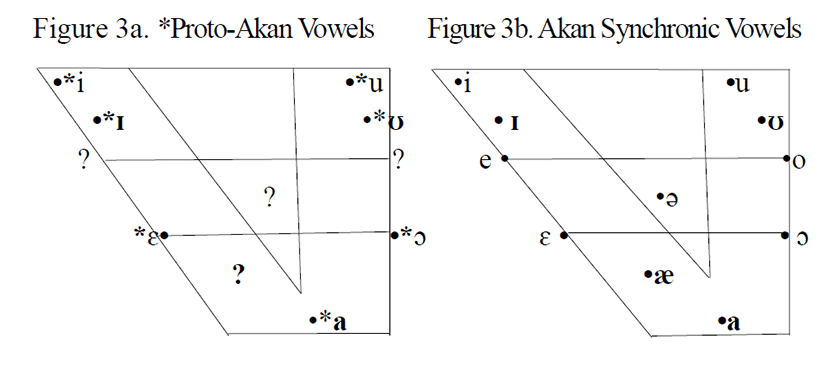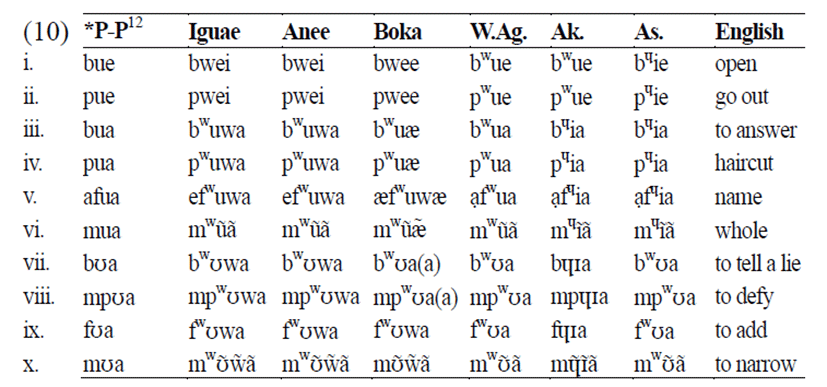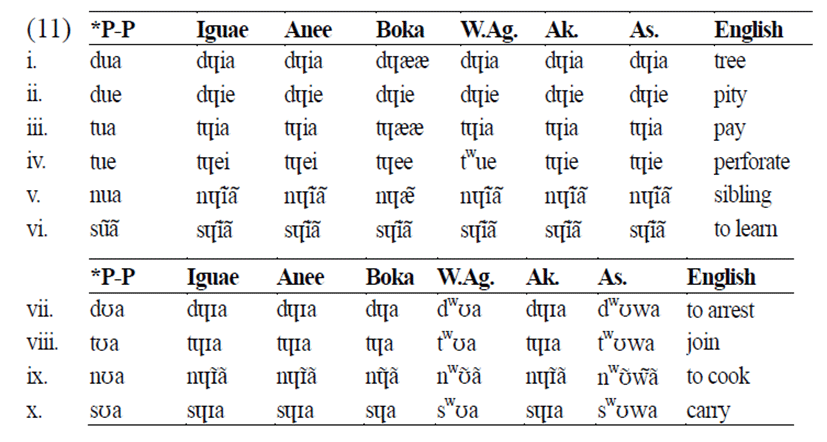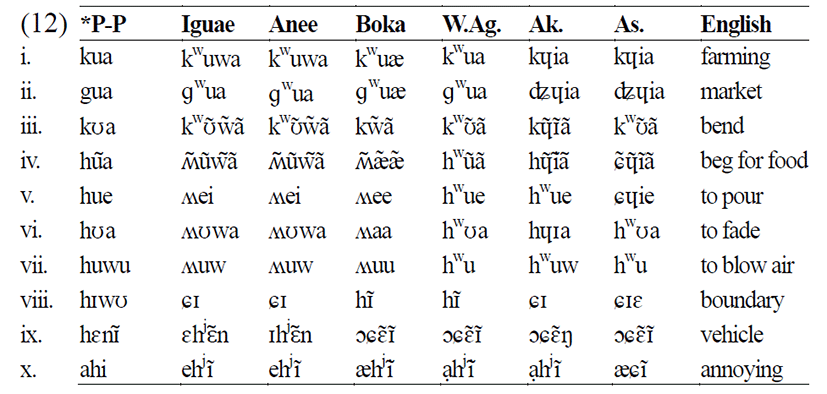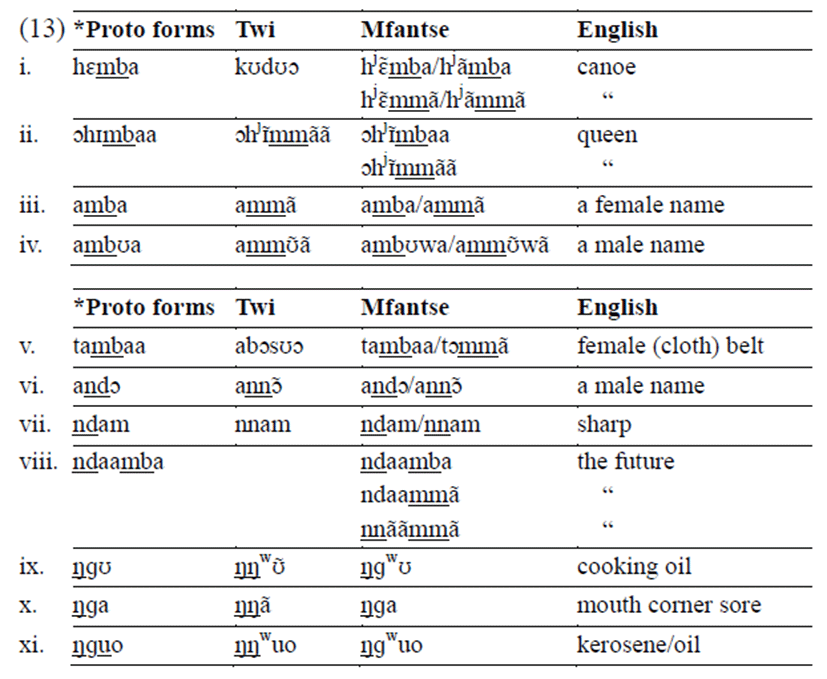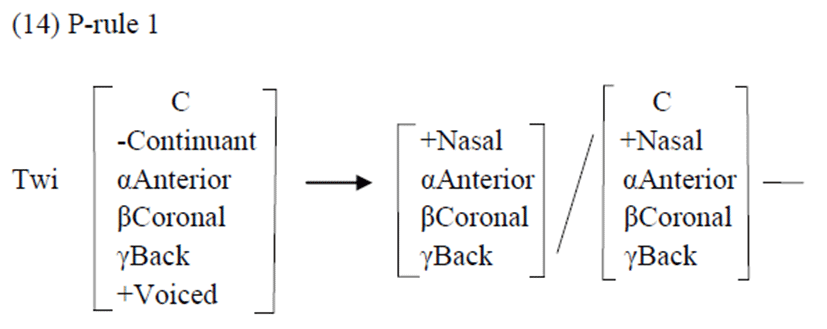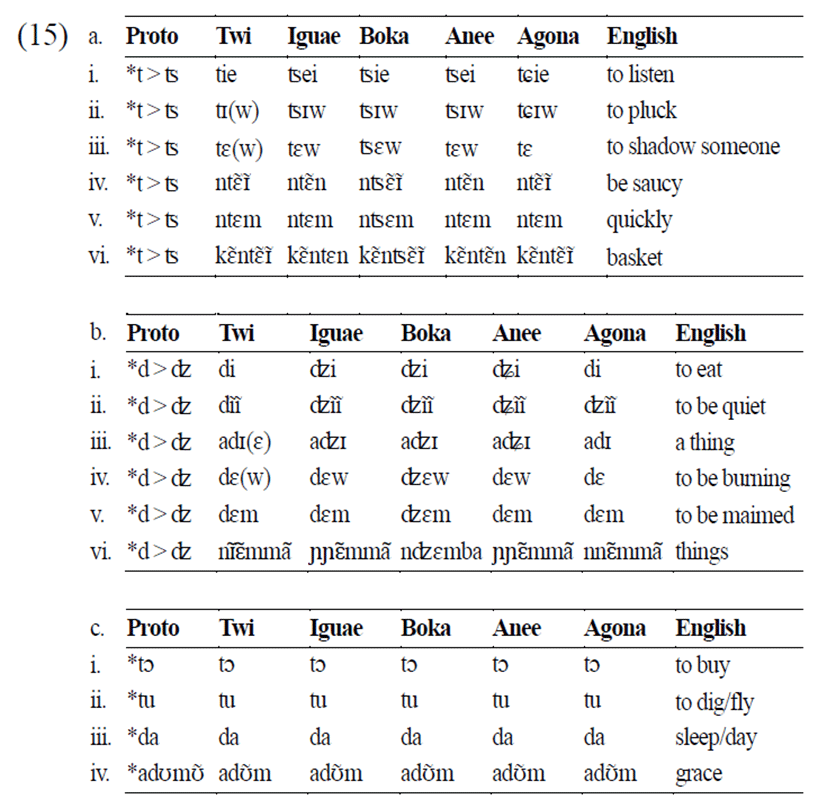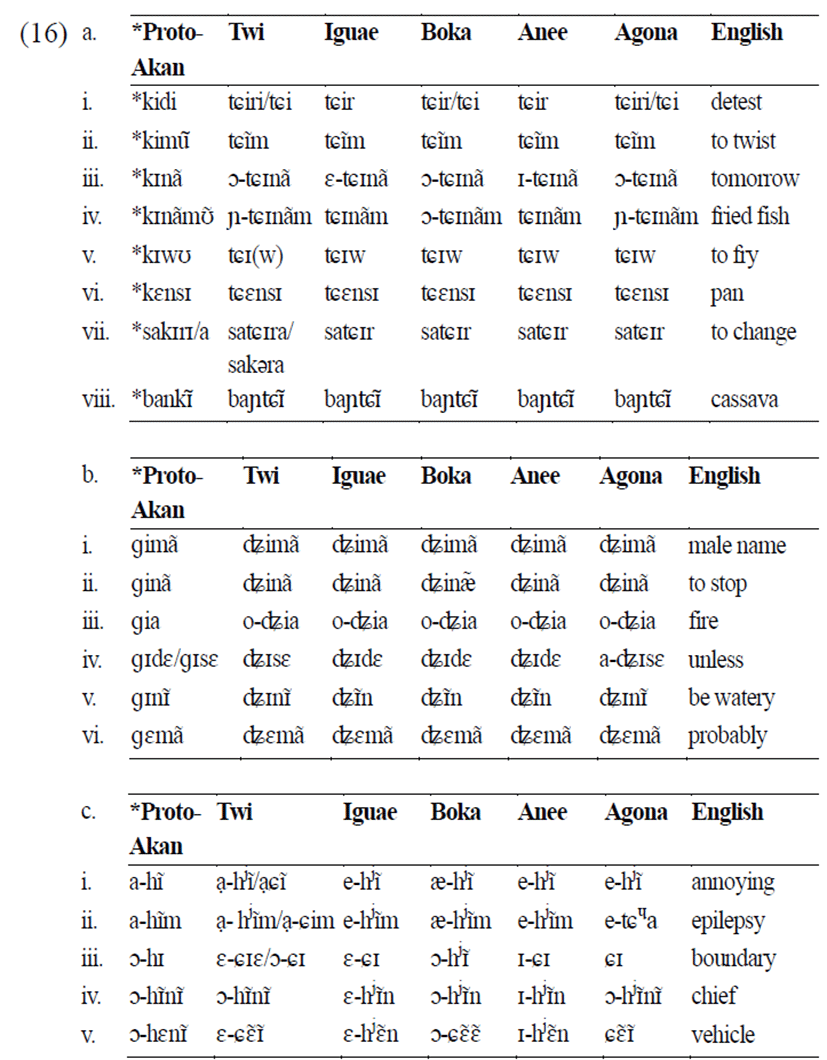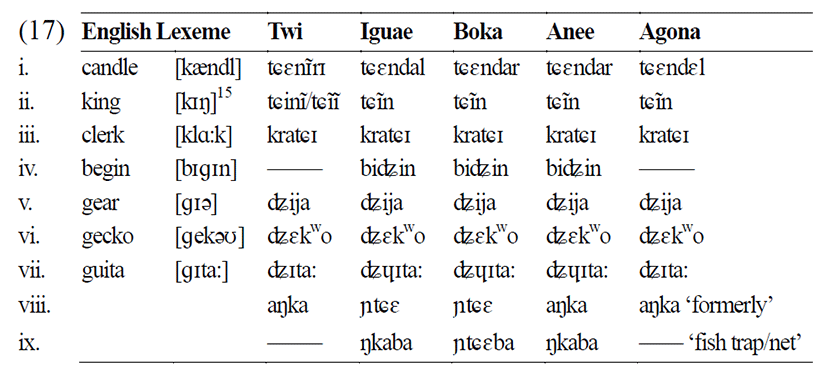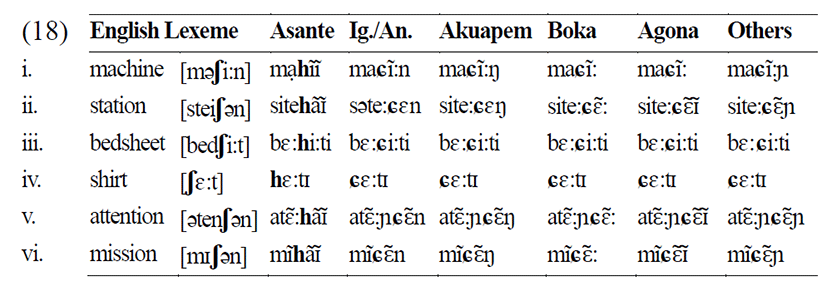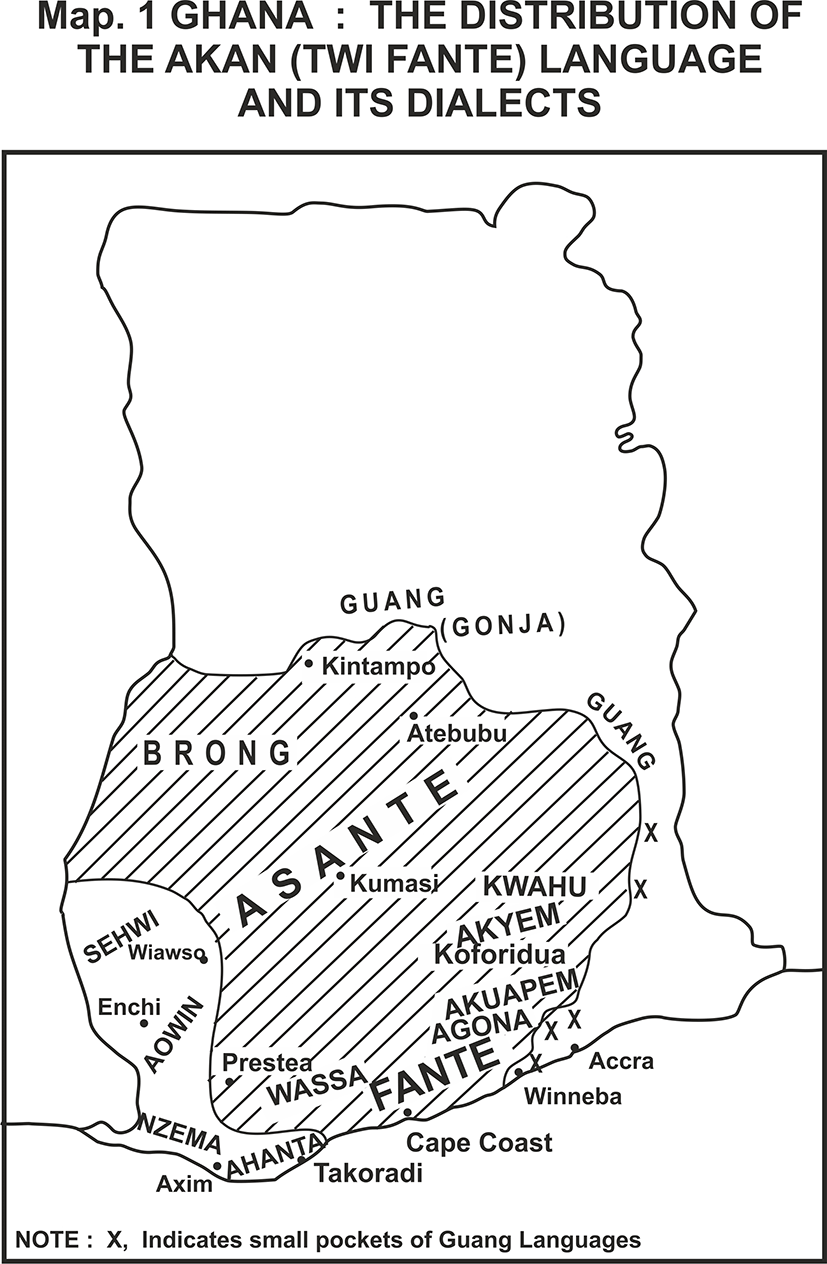1. Introduction
In the literature, the term Akan is used with both linguistic and ethnographic senses. As said by Obeng (1987) and Abakah (2003) this, to a large extent, creates confusion in the works of anthropologists and sociologists who, respectively, carry out anthropological and sociological studies of the Akan people and linguists who conduct linguistic research into the Akan Language Group (ALG). Thus, in this paper, we attempt to resolve the confusion by briefly telling between the ethnographic Akan and linguistic Akan since not all the Akan people speak the Akan language as their mother tongue (L1). Conversely, not all those who speak Akan as their L1 can be classified as absolute ethnographic Akan.
The inhabitants of most of the area lying between the Volta River in the eastern part of Ghana and the Bandama River in Côte d’Ivoire call themselves the Akan people whose distribution is captured by Map 12 adapted from Dolphyne (2006: 196). These people share similar cultural traits, which serve to differentiate them from other ethnic groups in West Africa. For instance, the languages and/or dialects they speak are closely related, having in common a large number of lexical items. These people include the Baule, the Aowin (Agni), the Sefwi (Sanvi), the Nzema, the Ahanta, Wassa, Mfantse3, Akwamu, Denkyira, Kwahu, Assin, Akyem, Asante, and Brong (Dolphyne 2006). There is no differentiation between the name of an ethnic group and the name of the language or dialect the people speak, i.e., the Nzema people speak the Nzema language, the Assin people speak the Assin dialect of Akan etc.
However, earlier linguists like Westermann & Bryan (1952), Greenberg (1963), Manoukian (1964), among others, used the term Akan to refer to the aforementioned group of languages. Stewart (l966, 197l) has labelled this cluster of languages as the Tano Language Group because they spread to the east and west of River Tano (see Map 1). The ethnographic Akan, therefore, refers to a very large group of people living in Côte d'Ivoire and Ghana who speak languages and/or dialects classified under the Tano language family to which the Akan language belongs.4 It is important to note that even though the Akuapem people speak the Akan language, they cannot be said to be absolutely ethnographic Akan by reason of the fact that their system of inheritance is patrilineal whereas all the constituent groups of the ethnographic Akan practise the matrilineal system of inheritance.
Map 2, also adopted from Dolphyne (2006), captures the distribution of the Akan language and its dialects. Maps 1 and 2 evidently show the geographic locations of the linguistic Akan and ethnographic Akan, respectively. The Akan language is spoken in Ghana by 44 per cent of the Ghanaian population (2000 census) as their L1 in the Brong Ahafo, Ashanti and Central Regions as well as in parts of the Western, Eastern and Volta Regions of Ghana. Akan is made up of three main dialects namely, Asante, Mfantse, and Akuapem in that they (these three Akan varieties) have been reduced to writing as each dialect has its own diverse orthography. Other dialects of the ALG include Bron (Bono), Wassa, Assin, Akyem, Kwahu, Akwamu, and Denkyira.
Stewart (1972) has classified the languages spoken by all the Akan people dichotomously as Bia and Akan. All the codes that constitute the ALG are mutually intelligible and the same can be said about all the constituent varieties of the Bia language group. However, all the Bia tongues of Agni (spoken in la Côte d’Ivoire), Ahanta, Baule, Brosa5, Chakosi, Evalue, Nzema, and Sefwi are, indisputably, dialects of the same language but, unlike Akan, they are not classified under a superordinate label. Each one is spoken of as a different language in the same way as the dialects of the ALG used to be spoken of in the past up to the 1950’s when the name Akan was adopted for the language group (Dolphyne 1988). It is interesting to note that Chakosi, which is located far away in northern Ghana is mutually intelligible with the Bia tongues located in southern Ghana. Besides, most Ahanta speakers understand and speak Nzema but the Nzemas do not make any effort to speak Ahanta even though the two linguistic communities share a common geographical border (Anthony Jerry Essien, personal communication)6. We present the language family table of the Tano Language Group below.
| Bia Language Group | ALG/Dialects |
|---|---|
| Chakosi | Assin |
| Baule | Akyem |
| Brosa (Aowin) | Asante |
| Agni | Kwahu |
| Sefwi | Akwamu |
| Nzema | Akuapem |
| Evalue | Mfantse |
| Ahanta | Bron |
| Wassa | |
| Denkyira |
The list of the dialects that make up the Akan language is not exhaustive. For further information on the ethnographic Akan, see Sarbah (1906), Manoukian (1964), and Obeng (1987).
We begin by looking at the Akan language and the languages with which it is genetically related. According to Greenberg (1963, 1966), the ALG genetically belongs to a group of languages of West Africa known as Kwa, which in turn belongs to a larger family of languages which he has labelled Niger-Congo. Since the publication of Greenberg (ibid.), the composition of Kwa has undergone comprehensive modification. Stewart (1989) and Williamson (1989) constitute the most up-to-the-minute published statement on the place of Kwa in the Niger-Congo family. For our present objective, it is adequate to state that Greenberg’s (ibid.) entire Eastern Kwa as well as Kru, Ijo, and the Togo Remnant languages have been detached from Greenberg’s (1963) original Kwa and re-assigned to his original Benue-Congo. On the strength of this proposal the “new-fangled” Kwa is, to all intents and purposes, Greenberg’s Western Kwa (Boadi 2009, n.d.).
A vital subgroup contained in Greenberg’s original Western Kwa or the “new-fangled” Kwa is his “Akan”. This has sometimes been referred to in the literature as Volta-Comoe. The taxonomic position of the Akan language and its dialects at levels below Kwa is more certain. The most recent phylogenetic classification of Stewart (1966, 1970) has proposed that Volta-Comoe or Greenberg’s Akan be re-labelled Tano as the following family tree diagram shows. See also Boadi (op. cit), Dolphyne (2006), and Abakah (2003).
Following Christaller (1875), Greenberg (1963: 8) applies the term Akan to refer to a subgroup of his Kwa. He then catalogues Twi, Anyi, Baule, Guang, Metyibo, and Abure as representing Akan (Obeng 1987; Abakah 2003; Boadi 2009, n.d.). While recognising Mfantse and Twi as greatly related dialects, Westermann & Bryan (1952: 78), on the other hand, group them with other languages as follows:
This grouping is identical with Greenberg’s Akan, except for the fact that it highlights the linguistic unity of Mfantse-Twi (Boadi 2009, n.d.). Westermann & Bryan (1952) have argued:
Akan was originally the collective name used to cover the inhabitants of Akuapem, Akyem, Asante (Ashanti), Akwamu, and some other territories but it is now used by Europeans to denote the whole group of people speaking the language of this group.
In this paper, we study the ALG, call it linguistic Akan. It is worth noting that all the speakers of the Bia languages are bilinguals who speak Akan as second language (L2). Interestingly, those ethnographic Akans located on the coast namely, the Ahanta, Evalue, and Nzema, basically speak Mfantse as L2 whereas those located inland like Aowin/Agni, Sefwi, and Baule fundamentally speak Twi as L2 even though most of them marvelously speak both Mfantse and Twi varieties of Akan impeccably (Anthony Jerry Essien & J. Crosby Annan, personal communication).
The Akan language is classifiable dichotomously as Mfantse and Twi inasmuch as all the non-Mfantse dialects are collectively referred to as Twi, which classification is clearly reflected in the title of Dolphyne (2006), “The Akan (Twi-Fante) Language: Its Sound Systems and Tonal Structure”. Since the Twi speakers of Akan are located inland and the Mfantse on the coast, the Akan language could be classifiable dichotomously as Coastal and Inland Akan (Abakah 1993, 2002). The following family tree captures this classification graphically/schematically.
It is obvious from the foregoing that historical linguists have already established the constituent varieties of the ALG as well as their relationships with other languages. What remains to be done is to reconstruct the *Proto-Akan forms and this is what this paper sets out to accomplish. One remarkable observation about language is that languages change through time. This is not to obscure the fact that it is, at least, conceivable that language could remain unchanged in the fullness of time, as is the case with some other human institutions e.g., diverse taboos in some cultures or the significance of frown as a nonverbal signal (Fox 1995, Joseph 2003).
All the same, the mutually comprehensible varieties of the codes that constitute the ALG have evidently undergone some changes over the course of time. However, they lack adequate written material that can take us far back into the history of the Akan language to enable any diachronic or historical linguist to determine the hypotheses on their development. Unavailability of written material results largely from the fact that all the members of the Niger-Congo language family are essentially located within preliterate societies. Besides, if empirical data from the sister Kwa languages or from the other daughters of the Niger-Congo parent language were readily available, then the reconstruction of the *Proto-Akan forms would be quite straightforward. But, unfortunately, these are also hard to come by, at least, for the moment. In spite of everything, to reconstruct a *proto-language, historical linguists have established a number of methods including the comparative method, internal reconstruction, language universals and linguistic typology among others. In view of the unavailability of written evidence and empirical data from the languages that are genetically related to the ALG, we will apply the Comparative Method (CM) in determining the hypotheses on the diachronic development of the ALG in this paper.
Synchronic linguistics invariably studies contemporary state of language whereas diachronic linguistics deals with changes that have occurred in the history of the language. It is widespread knowledge that in the real world situation past events are reconstructed on the strength of contemporary occurrences. Similarly, diachronic description of language cannot dispense with contemporary language state as the past forms of a language can be reconstructed from its present forms. Hence, synchronic linguistics is presumably a reflector of diachronic linguistics and, so, it would be an uphill task to carry out a project in diachronic linguistics without recourse to synchronic linguistics. In this paper, therefore, pieces of information and examples contained in Abakah’s works on synchronic phonology of Akan, especially Abakah (2012, 2013) have been reassembled in this paper to help us reconstruct the changes that occurred in the past from the present state of Akan phonology. *Proto-Akan segmental sounds would thus be determined and the changes that have occurred out of them in the past, resulting in development of “new” sound segments into the language, would also be discussed.
2. Basics of Diachronic Development of Language
Languages are not static, but they are constantly changing in the direction of development and, in some cases, extinction. The latest slang comes and goes, our own language is subtly but conspicuously different from that of our grandparents, and the further back we go in time the more distant and unintelligible the language seems to be (Fox 1995: 1).We also notice that some languages such as Norwegian, Swedish, and Danish share similarities with one another which historical linguists assume to be the direct result of the common origins of these languages. Over the course of time, languages (say, English, German, and Dutch) which might have been originally very similar like the Scandinavian languages are today, could diverge to the point where they might not be mutually intelligible (Abakah 2003). It behoves linguistics, specifically diachronic (or historical) linguistics, to attempt to answer questions relating to why and how these changes come about and the means that can be applied to find out. Denison (1997) and Bright (1997) have addressed these among other questions comprehensively (see also Coulmas 1997: 6).
Joseph (2003: 121) has remarked that scholars have long been intrigued by the mix of diversity and similarity that human languages show; and that one of the most promising among the hypotheses that have been advanced to explain this mix claims that, at least, some of the known languages show certain resemblances because they represent later instantiations of a once distinct speech community. In other words, it has been hypothesized that a particular speech community, through the accumulation of changes brought about by several linguistic factors aided by migration, resettlement, and physical split in the community can, in the fullness of time, break up and generate diverse, separate, and ultimately single speech communities. These resulting languages are said to be genetically related, where genetic, in the words of Joseph (2003), “has its etymological sense pertaining to origin not the more modern biological sense”. However, in order not to confuse genetic (relationship) with its biological use, linguists at times substitute genetic (relationship) with genealogical (relationship). The original speech community is referred to as proto-language (or parent language) for its several offspring languages. Hence, languages are said to be genetically related if they descended from the same ancestor language (Lyovin 1997). But the incidences of relationship between languages are invariably determinable through the application of the comparative method (CM).
3. The Theoretical Basis of the Paper
We have noted above that the ALG comprises mutually intelligible varieties that do not have adequate written material to enable any diachronic or historical linguist to determine hypotheses on their development. However, historical linguists have methods of reconstructing the history of the languages of preliterate communities like Akan. In this paper, we will adopt the same methods, especially the methods of reconstruction to come out with hypotheses on the development of the ALG.
To reconstruct a proto-language, as noted above, historical linguists have established a number of methods which, I repeat for emphasis, include the comparative method, internal reconstruction, language universals and linguistic typology. In historical linguistics, the Comparative Method and Internal Reconstruction are classical orthodox methods (Fox 1995: vi), and, they “remain the most important methods of reconstruction” (ibid: 7, Trask 1996: 248). Joseph (2003: 123) has also remarked that critical to the establishment of relatedness is the issue of methodology and, here, the most important method is the Comparative Method. Lehmann (1973: 75) has also argued, “A surer method of dealing with change and determining earlier forms … is known as comparative method.” For us to come out with hypotheses on the historical development of the ALG, we cannot dispense with the Comparative and Internal Reconstruction methods.
We have already established the constituent varieties of the ALG as well as their relationships with other languages. What remains to be done is to reconstruct the Proto-Akan forms and this is what this paper sets out to do within the framework of the CM. By the CM theory corresponding features, more usually segmental sounds in corresponding words but also morphemes and even syntactic structures, are compared with an eye to determining a set of systematic relationships that holds among the languages being compared. If such systematic correspondences can be found, then one can also draw inferences about the source from which the related languages did arise (Fox 1995, Joseph 2003).
According to Joseph (2003), “when the CM works, it is possible to make hypotheses about earlier states from which the related languages developed and to reconstruct (aspects of) ancestor languages that gave rise to the set of related languages in question”. For example, the recurring correspondence set involving Greek, Latin, and Sanskrit matching /f/ in Germanic (under certain conditions) has led most Proto-Indo-Europeanists to a reconstruction of /p/ for the sound in the source language (Proto-Indo-European) that gave rise to offspring languages (ibid.).
If an element A in one language can be systematically compared to a non-identical element B in another (putatively related) language, and the hypothesis is made that they derive from a reconstructed element C (usually affixed with * to indicate that the reconstruction is a hypothesis not an attested form), then at least one change has occurred — either A has changed and B reflects the reconstructed element faithfully or B has changed and A has not or both A and B have changed in different directions (Joseph, ibid.). Thus, as indicated by Joseph (ibid.), Fox (1995) among others, if we reconstruct the Proto-Indo-European *p for the set of Sanskrit p equals Germanic f, we are committing ourselves to the hypothesis that Germanic is innovative in this case. If we had reconstructed something like the *pf affricate, then there would have been change in all the languages being compared.
We first and foremost zero this study in on the “Uniformitarian Principle” which (Hock 1991: 630) defines as “The general processes and principles which can be noticed in observable history are applicable in all stages of language history”. We believe strongly, in line with the basic tenets of this principle, that observing change in progress at the present time presents insights that can be applied for untying aspects of language development in the past into which we have no other foundation for insight (Fox 1995, Joseph 2003). In other words, “with the Uniformitarian Principle we are licensed to make educated guesses about the past generated by our study of the present” (Joseph 2003).
4. The Vowels of the Akan Language Group7
We presume that a brief study of Akan vowels, in synchronic terms, will give readers some amount of insight into the diachronic study of the vowels of the ALG. Synchronically, Akan has, if the oral/nasal distinction is overlooked, basically ten vocalic segments viz. i, ɪ, e, o, ɛ, ɔ, a, æ, u, and ʊ. Nevertheless, a very hard look at research works on the Akan vowels via vowel harmony (VH) suggests that there is tacit disagreement over the number of vowels contained in the Akan vocalic catalogue. Some scholars argue that Akan has 9 vowels at the underlying level (u-level) of representation but 10 distinct ones at the phonetic level (p-level). Others maintain that Akan has 9 vowels at both u-level and p-level. Linguists who posit that Akan has 10 distinct phonetic vowels include Berry (1957), Stewart (1962, 1967, 1970, 1983), Schachter & Fromkin (1968), Dolphyne (1965, 1967, 2006), Dolphyne in Dakubu (1988), Abakah (1978, 1993, 2002), Eshun (1988, 1993), Boadi (1991), and Durand (1990). These distinguish the following 10 distinct vowels [i, ɪ, e, ɛ, u, ʊ, o, ɔ, a, æ] in the complete corpus of Akan and analyse them as being autonomous phonemes with the exception of the last one, æ, which is considered as an allophonic variant of a, specifically the [+ATR] counterpart of a (Abakah 2002, 2003, 2013).
Some Scholars, together with Carr (1993), Archangeli & Pulleyblank (1994), Kenstowicz (1994), Gussenhoven & Jacobs (1998), and Oyebade (1998), following Clements (1981), also argue that Akan has 9 vowels in its vocalic inventory at any level of representation, that is, at both u-level and p-level (Abakah 2003, 2004, 2012, 2013). In the words of Abakah (2003, 2013), “Clements (1981) argues convincingly that what some scholars refer to as [+ATR] counterpart of the low vowel is in fact not a [+ATR] vowel at all. He states categorically that
The contrast between the vowels a and ạ is not phonemic in Asante. [ạ] is raised and fronted low vowel (often transcribed [з]) which approaches [ɛ] in articulation, occurs to the exclusion of [a] in the following environments … (p. 114).”
The environments listed with long lists of examples point to the fact that ạ occurs in Asante in the environment of a following [+ATR] floating or nonfloating autosegment. Clements (ibid: 154) then goes on to posit that:
The set 2 vowels /ɪ ʊ ɛ ɔ a/ have the raised variants [ɪ̣ ʊ̣ ɛ̣ ɔ̣ ạ] when the first syllable of the following word begins with a [+high, advanced] vowel. In this context, set 2 high vowels merge completely with set 1 vowels: that is, [ɪ ʊ] = [i u], respectively. However, nonhigh vowels do not merge completely with set 1 vowels …
Clements (ibid: 156) further argues that:
It should be apparent that the rule … determining the occurrence of low vowel [ạ] is nothing but a special case of Vowel Raising. Notice that only /a/ is subject to the effect of Vowel Raising word-internally, since nonlow vowels will always undergo VH.
These linguists agree that the vowels of Akan, on the strength of their distributional pattern, are classifiable into two matching sets, Set I and Set II. Those linguists who claim that Akan has 10 distinct vowels at the p-level classify the ten vowels as follows:
Those who claim Akan has 9 vowels classify the vowels differently as follows:
The above classification, (3), seems to suggest that these scholars identify 4 [+ATR] vowels, 4 [-ATR] vowels and one neutral vowel; that is, the low vowel belongs neither to Set I nor to Set II. It is, therefore, not surprising that Kenstowicz (1994), Lee (1994), and others argue that besides being opaque in Akan, “the low vowel /a/ is neutral with respect to the vowel harmony” (Lee 1994: 85).
It is discernible from Abakah (2013, 2015) that there is a default V in the Mfantse variety, ə, which is invariably epenthesized in an appropriate reduplicative template to break unattested consonant clusters in the common Akan reduplication construction. In the same phonetic environment, the Twi varieties epenthesize any of the high vowels, /i, ɪ, u, ʊ/, to break the unattested C clusters (Abakah & Tenteh 2005; Adomako 2013). Selection of the V to be epenthesized is vowel harmony driven and, consequently, the epenthetic V to be selected from the above-listed [+High] Vs is dependent upon the quality of the base vocalism.
We assume that regardless of the number of vowels in the Akan vocalic inventory, Proto-Akan had only seven vowels, namely *i, *ɪ, *u, *ʊ, *ɛ, *ɔ, and *a in its vocalic directory. This fact will be made clear in the relevant portions of this paper. Let us examine the following data containing words which are historically related in the ALG.
A close examination of the examples in (4) reveals that in all contexts where Iguae has e Wasa-Agona consistently has a while Akuapem and Asante have ạ and Boka, æ. It must also be noted that e in Iguae is a which is raised to that tongue height position in order to agree with the vowels following it in being [+ATR] (Abakah 2013). ạ in Asante and Akuapem is basically an a that is raised, but not to the point of attaining [+ATR] status, when it occurs before a [+ATR] vowel. Thus, ạ is simply a raised version of a (Clements 1981, Archangeli & Pulleyblank 1994, Abakah 2003). In the related sister Kwa languages of Dangme, Ga, and Ewe (4iv) is produced as baŋkũ. Linguists generally claim that Ewe, Ga, and Dangme do not operate the VH system in their phonologies; for this reason, we do not expect a to alternate in order to agree with a following [+ATR] V in being [+ATR].
Moreover, it is infrequent to find the e sound in an Akan verb radical. All the vowels of Akan can constitute the syllabic peak of any CV syllable but not e, o, or æ8. Furthermore, in our data collection exercise, we asked countless interactants, mainly teachers, to come up with verbs in which the e sound features, regardless of quantity of syllables, and no one could get us any. This is not to obscure the fact that there could be few verbs in Akan in which e might feature. Data (5) below contain examples of Akan verbs with CV and CVC structures and, it clearly demonstrates that lexemes containing e as the base vocalism are lacking in Akan, at least, according to the data at our disposal.
In the Akan synchronic linguistics/phonology, if e emerges in any word belonging to any major class then it is underlyingly /a/ that is conditioned by an adjacent [+ATR] vowel, causing it to be raised to that mid vowel tongue position. However, ɪ in all the other varieties of Akan is replaced with e in only two verb radicals in the Boka Mfantse and Akuapem Twi varieties, which are captured as (5vii-viii) in the above data. It must also be noted that none of the varieties of Akan has æ occurring in phonological representations apart from the Boka variety of Mfantse (Abakah 2002, 2003). æ appears at the Akan phonetic surface much in the same way as e and ạ in the other varieties of the ALG as the examples in (4) demonstrate. It is, therefore, plausible to hypothesize that *Proto-Akan did not have æ and e in its segmental melody and that these vowels developed into the language from the *Proto-Akan vowel, *a, through the VH process. See also Boadi (2009) especially the section on vowel raising.
Another vowel that behaves in much the same way as e and æ is o, which also occurs in a few words in Akan in the context of a linked or floating [+ATR] vowel. Besides, it cannot be found in any major word class in any of the Akan varieties. Let us examine the following data for exemplification:
Apart from a few nouns that appear to have o as the root vocalism, as reflected in (6ii) and (6iv), the Akan varieties in the list do not have a common V and that even where o is not in the orthography some of the dialects have it as stem vocalism. Certainly, there is no verb radical in Akan that has o as its vocalism and that all verb stems that appear to have o as their vocalism as in (7i, iii-v) happen to be compound words in which the o occurs in the environment of a following [+ATR] vowel. The orthographical forms in the first column reflect this fact. In other words, o does not occur in Akan phonological representations but it appears at the phonetic surface in many words via the VH process by which a [+ATR] V conditions a preceding ɔ to transmute to o. This brings us to the conclusion that Proto-Akan did not have [+ATR] mid vowels and that e and o developed out of the VH process in Akan.
Having assumed that o did not occur in *Proto-Akan, we need, at least, one or two other pieces of conclusive evidence to enable us to confidently hypothesize rightly as to whether or not o developed into the present day Akan language from some other vowel(s). These kinds of evidence include
-
• documentary data that takes us far back into the history of the Akan language, and
-
• empirical data from the sister Kwa languages or from other daughters of the Niger-Congo parent language.
In the absence of such evidence we can simply, based essentially on o’s distribution in the constituents varieties of the ALG, hypothesize that o developed into the Akan language relatively recently.
There is one particular word in Akan whose etymology is highly discernible. It has not completed the metamorphosis which it is undergoing. Consequently, it provides evidence that reinforces our theory that e and o were not part of the Proto-Akan vocalic inventory; they actually came into the Akan language over the course of time. This word meaning an enchanter/a person who prays/a Muslim, in Akan, has four distinct realizations at the p-level which are:
-
• kramoɲi (Ig./Bk.) / kramoni (all the other varieties of Akan)
-
• krạmoni (Twi)
-
• kræmoɲi (Bk.)
-
• kremoɲi (Ig./Bk.) / kremoni (An.)
It is a compound word made up of the following free forms: kramʊ ‘to pray/to enchant’ and nĩ/ɲĩ ‘a person/agentive morpheme’. It could be straightforwardly argued that the a and the ʊ in kramʊ should naturally become ạ/æ/e and u, respectively, in line with the Akan VH process by which any vowel prespecified as [+ATR] often spreads leftwards and sometimes rightwards, to all [-ATR] vowels preceding or following it in a lexeme. Thus, when ɲi/ni is attached to kramʊ on the right, the i in ɲi/ni being a [+ATR] vowel, as would be expected, spreads to all the Vs of the preceding element, kramʊ, thereby generating [krạmoni] / [kræmoɲi] / [kremoɲi] / [kremoni] at the p-level. It is important to note that the u in kremu/kræmu undergoes vowel lowering thereby yielding o at the output level; hence, kremo/kræmo.
Let us illustrate this account graphically with the following derivation:
This account, looked at in isolation, may not actually give credence to our hypothesis because a and ʊ, occurring in an identical phonetic environment, will naturally become æ/e and u, respectively, due to the VH/vowel replacement (VR) effect (Abakah 2013). However, it is interesting to note that the term for ‘the Islamic religion’, has four diverse pronunciations, kramo, krạmo, kræmo, and kremo, which exhibit the mutation of the Proto-Akan word-final ʊ of kramʊ to o via vowel lowering process. Based on the various ways by which the o vowel surfaces at the Akan p-level, it is conceivable to presuppose that o developed quite recently into the ALG through vowel raising from ɔ to o and through vowel lowering from ʊ to o.
The fact that this word has four diverse phonetic representations is explicable by the fact that it has not fully gone through the process of metamorphosis. With some speakers of Akan, a is yet to mutate to ạ, æ, or e whilst with others the change has already taken place. It is fascinating to note that those speakers who have already replaced a in kramʊ with either ạ, æ, or e often pronounce it with the proto *a. This, therefore, reflects the fact that most speakers of Akan use kramo, krạmo, kræmo, and kremo interchangeably. This word, needless to say, largely demonstrates not only how *a transforms to ạ, æ, and e but also how ʊ transmutes or lowers to o in Akan, thereby reinforcing our hypothesis that æ, e, and o did not occur in *Proto-Akan.
In summary, therefore, æ and e developed into the ALG from *a via vowel VR and VH processes whereas, o entered the Akan vocalic inventory from *ʊ and ɔ through V-lowering and V-raising processes, respectively (Abakah 2013). Based on the foregoing study, we present the *Proto-Akan vowel phonemes as Figure 3a and the Akan synchronic vowels as Figure 3b.
5. The Consonants of the ALG
The ALG had 13 *proto-consonants as captured in Figure 4 below. Out of these Cs, not less than 63 phonetic consonants have developed into the language group. In this section, we study the *proto as well as synchronic Akan consonantal segments. Besides, we will study how some non-proto consonants developed into the language group out of some of the *proto-Cs.
Presently, Akan has the following 14 systematic consonantal phonemes /p, b, t, d, k, ɡ, m, n, r, f, s, h, j, w/. See Abakah (1993, 2003, 2004) and Eshun (1993) for a detailed study. We have no reason to assume that all these consonants are members of the Proto-Akan segmental list. Some scholars, including Schachter (1962) and Schachter & Fromkin (1968), argue that r is not a true consonant of Akan but was rather borrowed from the English language. This argument has some degree of credibility, that is, it is not a constituent of the Proto-Akan consonantal inventory. However, for them to argue that Akan borrowed it from the English language smacks of overstatement even as it is totally untenable. Eshun (1993) and Abakah (1993, 2003, 2004), with primary data plus secondary data from Dolphyne (1988), have proven that the argument in question does not reflect the true state of affairs.
We establish below, the Akan consonantal *proto-phonemes as in Figure 4:
Out of the fourteen (14) systematic phonemes in the present day Akan consonantal inventory, only r/l did not occur as a proto-phoneme. The distributional pattern of r/l indicates that r appears at the Akan phonetic surface through the process of d-liquidization (Abakah 2003). It invariably occurs intervocalically in free variation with d/l. It can occur word-finally only when the high vowel it precedes at word-final position deletes (ibid.). Schachter & Fromkin (1968) have asserted that m and n do not occur in Akan phonological representations thereby eliminating completely the possibility of nasal consonants being Akan *proto-phonemes. But Abakah (2003, 2004) has counterexemplified and falsified the foundations of their argument. So, apart from the thirteen (13) proto-phonemes presented in Figure 4 above, all other consonantal segments in the ALG are purely phonetic (Abakah 2003, 2004) developing out of the *proto-Cs.
Here, too, we presume that to appreciate the diachronic study of the Cs of the ALG, an insight into the synchronic linguistics of the *proto-Cs of that language group is valuable. In this subsection, we briefly touch on the phonetic consonants which, we think, would throw light on the non-proto consonants, of the language group in question.
The *Proto-Akan Cs did invariably undergo secondary modifications when they preceded a V in a lexeme. Thus, roughly sixty-three (63) phonetic Cs appear at the p-level in the synchronic phonology of all the known varieties of the ALG. Examples of words in which the phonetic consonants of Akan occur are listed in (9) below. Some of the phonetic consonants are dialect specific. So, in (9), adapted from Abakah (2003, 2004), the words in which a particular phonetic consonant peculiar to a particular variety of Akan occurs, the counterpart pronunciations in the other dialects are not indicated. Consequently, a dash is put in the columns of the dialects that lack a particular phonetic consonant.
It is worth pointing out at this juncture that we have selected only three dialects of the ALG which constitute a true representative of all the varieties of that language group. This is because the Cs in these varieties cover all the Cs contained in the segmental inventories of all the constituent varieties of that language group.
These numerous phonetic consonants occur at the phonetic surface as a result of application of various phonological processes as noted earlier. These processes include labialisation, palatalisation, labial palatalisation and stridentisation.
Based on the Uniformitarian Principle we are going to, by our study of the present, make educated guesses about the past in terms of the diachronic development of the consonantal melodies of the ALG in this section. We will show how such consonants developed diachronically into the Akan consonantal catalogue. Let us begin by examining data (10), (11), and (12) below which contain anterior, coronal, back, and C-Placeless Cs, respectively.
According to the Neogrammarian Hypothesis (a conclusion based on successful use of the comparative method), reconstruction revolves around the notion that sound change is mechanical and exceptionless. If a *proto-/p/ becomes /f/ in a daughter language, it does so in a regular fashion. If there are exceptions, there must be some other conditioning factor (Fox 1995, Trask 1996, Joseph 2003). The data I have just given above give weight to the Neogrammarian Hypothesis in that the phonological changes in the ALG are very regular. The exceptions are also systematically conditioned by phonological factors.
From the above data (10), (11), and (12), it is instantly decipherable that in Asante Twi, every C in a CUa/e string developed into a labial palatal(ised) C in the context before a U that had the [+ATR] specification in its feature matrix as exemplified by (10i-vi), (11i-vi), and (12i-ii, iv-v). But where the U was unspecified for the [+ATR] feature, the plain C developed into a labialised C while the palatalisation element was put on hold as (10vii-x), (11vii-x), and (12iii, vi) demonstrate.
In the Mfantse varieties of Iguae, Anee and Boka, if the C in the string in question were coronal, then it was labial palatalised regardless of the ATR quality of the U, as data (11) illustrate. Any other consonant, be it anterior or back was simply labialised except for the C-Placeless h which developed into the labial velar fricative, ʍ. In both instances, after the labialisation or labial velar frication processes had taken place, the labial velar glide, w, depending on subdialect or lexeme, was epenthesized to break the Ua/e sequence.
In the Akuapem Twi, every C of the string labial palatalised irrespective of its feature specification and the ATR quality of the U. However, when the C was p or b, and the U and the final V were u and e, respectively, the process of labial palatalisation was shelved as illustrated by (10i-ii) and (12v).
From the foregoing, it becomes abundantly evident that the changes from the *Proto-Akan Cs to labial palatal(ised) ones have been regular but with exceptions which were also conditioned by regular phonological process(es) in line with the Neogrammarian Hypothesis. The only time that the changes from *proto Cs to labial palatalized Cs failed to materialize in the various constituents of the ALG have been clearly spelt out above and are undoubtedly regular. The change in question affected only coronal consonants in the Mfantse varieties whereas in the Twi varieties all consonants are subject to labial palatalisation provided the requisite requirements have been satisfied. Based on the above data and account, it is conceivable to theorize that the development of labial palatalized Cs from their respective Proto-Akan phonemes was occasioned by diverse phonological factors in different dialects/subdialects.
In Akan not all the m, n, and ŋ nasal consonants are phonemic. Some are rather allophonic that developed out of *Proto-Akan voiced plosives. Thus, a sequence of two nasal consonants in the language did not occur as a result of consonant germination but rather, as demonstrated by the data below, via the assimilation of voiced plosives by a preceding homorganic nasal C. This development has occurred in all the Twi varieties of Akan diachronically to the extent that it is impracticable to have a N-VPl13 sequence in Twi. In Mfantse, on the other hand, such a development has started somewhat recently and could be found in very few lexemes most of which, if not all, constitute the data below. Hence, a sequence of N and VPl which occurs in a lexeme at the u-level in all the varieties of Mfantse have two interchangeable productions at the p-level, one representing the ongoing change and the other representing the *Proto-Akan forms; these are both in use at the synchronic level as the data below illustrate. In (13), the homorganic nasal C and the following target, voiced plosive, are underlined.
It is discernible from data (13) above that post-N /b/ or /d/ in some Mfantse lexemes has developed into nasalized consonant identical to the preceding /m/ or /n/, respectively. Here, as noted above, the proto forms and the changed forms are used interchangeably as the examples illustrate. The following phonological rule (P-rule) gives a graphical representation of the diachronic / developmental process in question:
This rule states that a voiced plosive C whether anterior, coronal or back (i.e., a C, whether b, d, or ɡ) in Twi becomes a nasal consonant in the context after a nasal consonant with which it is homorganic. The development involving the postnasal, voiced, anterior, and coronal noncontinuant Cs into nasal Cs (i.e., *mb > mm, and *nd > nn, respectively) has begun relatively lately in the Mfantse varieties of Akan. Clearly, the development is ongoing and there is not the minutest trace of the development of the high, back, voiced, noncontinuant C into the high/back nasal C (i.e., *ŋɡ > ŋŋ) would ever come about in any known Mfantse variety.
The *Proto-Akan coronal/alveolar plosive consonants *t and *d developed into assibilated ʦ and ʣ, respectively, in most of the Mfantse varieties of Akan when they occurred in the environment of a following palatal vowel. In other words, these consonants changed to spirants through a process generally referred to as assibilation which Abakah (2003, 2004, 2012) has variously referred to as spirantisation, stridentisation and affrication. Abakah (1978, 1993), Obeng (1989), and Dolphyne (2006) have referred to the same process as palatalisation; rightly so, because that consonantal shift happened in a palatalising environment. The Twi varieties of Akan, on the other hand, have not gone through such diachronic development, thus sticking to the *Proto-Akan forms of these consonants as the following data illustrate:
The alveolar plosives in all the examples in data (15c) above have not undergone assibilation inasmuch as they do not occur in the phonetic environment that elicits the assibilation process. But in (15a.i-vi) and (15b.i-vi), *t and *d, respectively, in Boka Mfantse have been assibilated to ʦ and ʣ, respectively, whereas in the other varieties of Mfantse the assibilation process, as (15a.iii-vi) and (15b.iv-vi) respectively show, is yet to happen in some lexemes even though all structures required for this change in question have been in place. Data (15a.i-ii) and (15b.i-iii) reveal that in Agona and Anee, respectively, the assibilated outputs (ʦ and ʣ, respectively) undergo palatalisation yielding ʨ and ʥ, respectively.
The development of the *proto-Akan *t to ʦ and *d to ʣ have been completed in all the varieties of Mfantse in the environment of high palatal vowels,i and ɪ, but got promoted to ʨ and ʥ in Agona and Anee, respectively. These developments could be stated schematically as: *t > ʦ > ʨ and *d > ʣ > ʥ in Agona and Anee, respectively. In any case, the development of *t to ʦ (*t > ʦ) and *d to ʣ (*d to ʣ) in the context before the mid palatal vowel, *ɛ, have occurred in Boka only. Nevertheless, assibilation of the coronal Cs in question in the context before ɛ appears to be in progress as they have not as yet taken place in the other varieties of Mfantse, i.e., Iguae, Anee, Agona and Breman. Generally speaking, Mfantse can be said to be innovative, with the Boka variety being proactively innovative, whereas Twi is conservative in this context.
Only one palatal consonant ever existed in *proto-Akan, that is, j and its allophonic variant, ɲ which occurs in the environment of a following nasal V. However, whereas ʨ and ʥ have developed into the language group through the two *proto-Akan dorsal plosives *k and *ɡ, respectively, ɕ has developed out of *h even though it is not a dorsal C (Abakah 2012). There is a trace of evidence in the language group that confirms the fact that ʨ, ʥ, and ɕ have truly developed into the language group out of *k, *ɡ, and *h, respectively. Besides, the language group produces output k and ɡ in some adapted English loanwords as ʨ and ʥ, respectively, which also confirms this fact significantly. Conversely, ʃ in some English lexemes borrowed into the language is produced as h by Asante Twi speakers which also validates our theory that ɕ developed into Akan out of h (cf. §5.7). Let us painstakingly scrutinize the data below for exemplification:
It is deducible from (16a) that proto-Akan *k developed into ʨ (i.e., *k > ʨ) whereas in (16b)*ɡ developed into ʥ (i.e., * ɡ > ʥ) in the history of the language.14
Furthermore, phonetic k and ɡ that occurred in a palatalising environment in some English lexemes borrowed into the ALG have been interpreted and treated as proto *k and *ɡ, respectively. Hence, they have been palatalised in Akan thereby giving credence to the fact that ʨ and ʥ developed from k and ɡ, respectively, into the ALG. Let us examine (17) for illustration.
In his study of Akan (Twi) loanword adaptation, Adomako (2013) has also observed that some k and ɡ in English borrowed or codeswitched lexemes in the language undergo palatalisation if they occur in a palatalising environment.
Usually, dorsal plosives in English lexemes borrowed into the ALG in the past were palatalised provided they occurred in the environment of a following palatal vowel as exemplified by (17) above. However, in (17i), even though the vowel from the donor language is [+Low], k being [+High] conditioned the low vowel in the recipient language to be raised to become the mid palatal vowel, ɛ, which consecutively caused the k to submit to the process of palatalisation. In (17iii), since k does not occur at word-final position in any of the known Akan varieties, borrowed English lexemes with a non-sonorant final C is pushed to the penultimate position by epenthesizing a high palatal V at lexeme-final position. This creates a perfect environment necessary for the application of the total palatalisation process. This explicates the presence of ʨ in the derived output of (17iii), which points to the fact that ʨ developed into all the varieties of the ALG, out of the *k proto-phoneme.
A similar situation exists among the members of the ALG in terms of Akan lexemes. Whilst some members retain a u-level low V following k in a lexeme at the p-level, other varieties raise the low V to ɛ thereby creating a perfect condition for palatalisation of the velar plosive. Hence, the latter varieties submit the k to the palatalisation process thereby generating such outputs as (17vii-viii). At any rate, all the examples in (17) provide evidence that ʨ and ʥ in the Akan consonantal inventory developed out of the proto-phonemes, *k and *ɡ, respectively.
In this section we focus on another factor which gives weight to our hypothesis that ɕ in Akan developed out of *h. Incidentally, English loanwords in the ALG in which the palato-alveolar C, ʃ, precedes a palatal V, Asante have replaced it with h. Examples include the following:
In all the varieties of the ALG, as the above data illustrate, the palato-alveolar C, ʃ, in English lexemes borrowed into Akan has been invariably substituted with the alveolo-palatal C, ɕ, except for the Asante variety which has replaced it with h. It is, for this reason, plausible to hypothesise that Asante processes the English palato-alveolar ʃ as originating from *proto h thereby treating it as if it were in an Akan lexeme. Consequently, Asante has not subjected the perceived h to the palatalisation process even though it occurs in a palatalising environment. This is normal or rather the case in Akan by which most lexemes in which h, occuring in a palatalising site, does not undergo the palatalisation process. This is because the mutation of h to ɕ in the ALG is a very recent development that is yet to gather momentum.
Paradoxically, Asante has begun a process of palatalising the C-placeless h in two lexemes in the language in the environment of a following high palatal V. In these words, no other variety of Akan has palatalised the h in that palatalising environment as the examples in (16c.i-ii) demonstrate, and which we repeat below as (19i-ii) for straightforward reference.
This development in Asante, to a large extent, throws a broad light on, confirms, and gives credence to our hypothesis that ɕ in the ALG originated from *h. But the foregoing reveals that this development (*h > ɕ) in Akan is an ongoing phenomenon. The output, ạɕĩ, in (16c.i/19i) in Asante Twi, for instance, is the most recent development in the whole ALG and this began roughly not more than a decade before. In the other lexemes in the entire data (16) *h has not developed into ɕ across all lexemes within the constituent varieties of the ALG. This piece of evidence largely corroborates our theory that ɕ developed into the language group out of *h. The development began quite recently and, observably, it is ongoing in all the varieties of Akan with the Asante Twi variety being more innovative.
6. Conclusions
In this paper, we have attempted to reconstruct how certain autonomous phonemes and allophones, both vocalic and consonantal alike, developed into the ALG. We have posited that *Proto-Akan had seven vowels namely /i, u, ɪ, ʊ, ɛ, ɔ, a/ in its vocalic inventory but over the course of time /e, o, æ-ạ, ə/ developed into that language group via the VH process. We have also argued that Proto-Akan had 13 consonantal phonemes but there are presently as many as 63 phonetic consonants in Akan.
We have also demonstrated in this paper that some nasal consonants in Akan are indeed nasalized consonants, by reason of the fact that any sequence of identical nasal consonants (i.e., N1-N2) in Akan does not reflect consonant germination but rather the N2 happens to be an underlying voiced plosive assimilated into a nasalized consonant diachronically by N1. In other words, in a sequence of identical N1-N2 consonants in Akan, the N1 is invariably phonemic whereas the N2 is phonetic. Furthermore, we have, in this paper, also shown that Proto-Akan coronal consonants *t and *d developed/assibilated into ʦ and ʣ, respectively, in Mfantse. These changes have been assumed to have happened much recently. However, while the change of *t to ʦ is comparatively extensive, that of *d to ʣ is less extensive. It has been illustrated that these changes are systematic, thereby giving credence to the Neogrammarian concept of changes being invariably systematic and exceptionless.
We assume that in view of the fact that diachronic study of Akan linguistics, like those of most African languages, has received scant attention in the literature probably due to the fact that written evidence of historical changes in all our Black African languages (redundantly belonging to preliterate societies) is lacking. This study is therefore presumed to constitute a challenge to scholars to take up research into the diachronic linguistics of the various Ghanaian/African languages in order to promote diachronic studies of our languages.
In this connection, we concede the fact that this study is not exhaustive seeing that diachronic change does not affect segmental sounds only but also lexemes and syntactic structures. This paper has been silent on diachronic changes in terms of lexemes and syntactic structures of the ALG just to cut down on its volume. Abakah (2010) for instance has, following Boadi (nd, 2009), dropped some hint on the loss of the associative morpheme in the Twi varieties of Akan. Abakah (op. cit.) has argued that the morpheme in question lost its *proto segmental support only leaving behind its high tone (H) melody which invariably docked to the initial tone of the possessed NP even as the Mfantse varieties have retained both the segmental and tone melodies of the morpheme. He has for that reason propounded theories for the loss of the said associative morpheme. Dolphyne (2006) has also referred to a floating H being the associative morpheme in Twi. All these studies are not cast within the realm of diachronic linguistics, and it would be fascinating if linguists could study this and other syntactic structures that have developed or are developing into the language group. It has, in reality, come to our realization that the exclusive focus marker, na, is falling into disuse in Mfantse focus-marked sentences whereas Twi speakers retain the proto form. We believe that this can also constitute an interesting section in a study on diachronic development of syntactic structures in the ALG.

